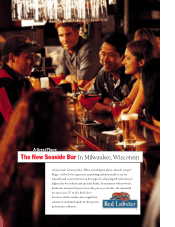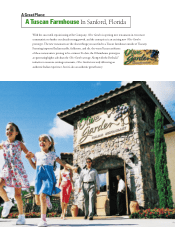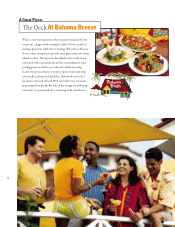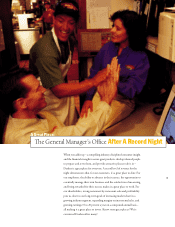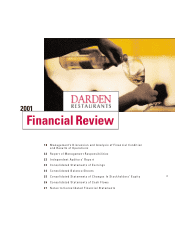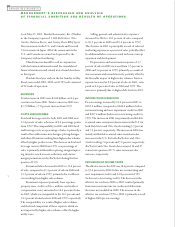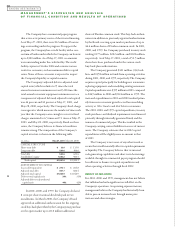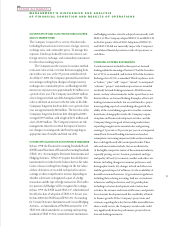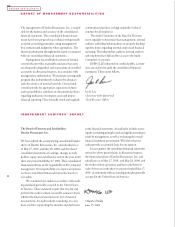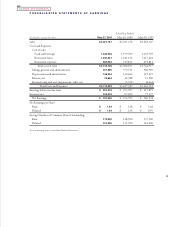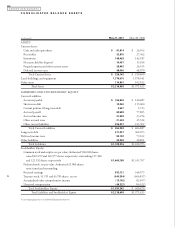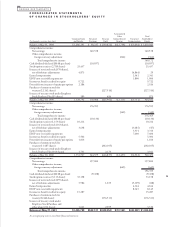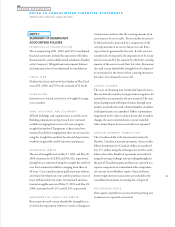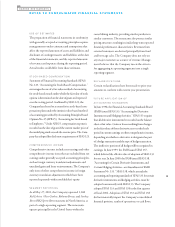Red Lobster 2001 Annual Report Download - page 21
Download and view the complete annual report
Please find page 21 of the 2001 Red Lobster annual report below. You can navigate through the pages in the report by either clicking on the pages listed below, or by using the keyword search tool below to find specific information within the annual report.
MANAGEMENT’S DISCUSSION AND ANALYSIS
OF FINANCIAL CONDITION AND RESULTS OF OPERATIONS
NET EARNINGS AND NET EARNINGS PER SHARE
BEFORE NET RESTRUCTURING AND ASSET
IMPAIRMENT CREDIT
Net earnings for 2001 of $197.0 million, or $1.59 per
diluted share, increased 13.8 percent, compared to 2000
net earnings before net restructuring and asset impair-
ment credit of $173.1 million, or $1.31 per diluted
share. Net earnings before net restructuring and asset
impairment credit for 2000 increased 27.9 percent,
compared to net earnings before restructuring credit for
1999 of $135.3 million, or $0.96 per diluted share.
NET EARNINGS AND NET EARNINGS PER SHARE
Net earnings for 2001 of $197.0 million ($1.59 per diluted
share) compared with net earnings after net restructuring
and asset impairment credit for 2000 of $176.7 million
($1.34 per diluted share) and net earnings after restruc-
turing credit of $140.5 million ($0.99 per diluted share).
During 1997, an after-tax restructuring and asset
impairment charge of $145.4 million ($0.93 per diluted
share) was taken related to low-performing restaurant
properties in the U.S. and Canada and other long-lived
assets, including those restaurants that have been closed.
The pre-tax charge included approximately $160.7 mil-
lion of non-cash charges primarily related to the write-
down of buildings and equipment to net realizable value
and approximately $69.2 million of charges to be settled
in cash related to carrying costs of buildings and equip-
ment prior to their disposal, lease buy-out provisions,
employee severance, and other costs. Cash required to
carry out these activities is being provided by operations
and the sale of closed properties.
After-tax restructuring credits of $5.2 million and
$5.2 million were taken in the fourth quarter of 2000 and
1999, respectively, as the Company reversed portions of
its 1997 restructuring liability. The 2000 reversal prima-
rily resulted from favorable lease terminations. The 1999
reversal primarily resulted from the Company’s decision
to close fewer restaurants than identified for closure as
part of the initial restructuring action. The credits had no
effect on the Company’s cash flow.
During 2000, an after-tax asset impairment charge
of $1.6 million was taken in the fourth quarter related
to additional write-downs of the value of properties
held for disposition.
FINANCIAL CONDITION
Short-term debt totaled $12.0 million as of May 27,
2001, down from $115.0 million at May 28, 2000.
The decrease resulted primarily from the Company’s
issuance of long-term debt, in which the proceeds
were used to repay short-term debt.
LIQUIDITY AND CAPITAL RESOURCES
The Company intends to manage its business and its
financial ratios to maintain an investment grade bond
rating, which allows access to financing at reasonable
costs. Currently, the Company’s publicly issued long-term
debt carries “Baa1” (Moody’s Investors Service), “BBB+”
(Standard & Poor’s), and “BBB+” (Fitch) ratings. The
Company’s commercial paper has ratings of “P-2” (Moody’s
Investors Service), “A-2” (Standard & Poor’s), and “F-2”
(Fitch). Such ratings are only accurate as of the date of this
report and have been obtained with the understanding
that Moody’s Investors Service, Standard & Poor’s, and
Fitch will continue to monitor the credit of the Company
and make future adjustments to such ratings to the extent
warranted. The ratings may be changed, superseded, or
withdrawn at any time.
Darden’s long-term debt includes $150 million of
unsecured 6.375 percent notes due in February 2006
and $100 million of unsecured 7.125 percent deben-
tures due in February 2016. In September 2000, the
Company also issued $150 million of unsecured 8.375
percent senior notes due in September 2005. Proceeds
of the issuance were used to repay short-term debt.
In November 2000, Darden filed a prospectus
supplement with the Securities and Exchange Commis-
sion allowing the Company to offer up to $350 million
of medium-term notes from time to time. The notes will
be unsecured, may bear interest at either fixed or floating
rates, and may have maturity dates of nine months or
more after issuance. In April 2001, the Company issued
$75 million of 7.45 percent fixed rate notes under this
program with a maturity date of April 2011. Proceeds
of the issuance were used to repay short-term debt.
As of May 27, 2001, Darden’s long-term debt also
includes a $44.5 million commercial bank loan that is
used to support two loans from the Company to the
Employee Stock Ownership Plan portion of the Darden
Savings Plan.
19
2001
DARDEN RESTAURANTS



